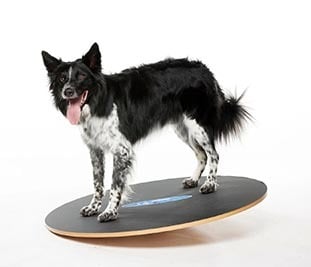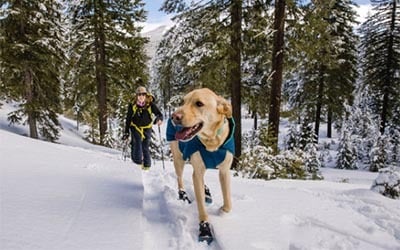Canine Injury Prevention: Safeguarding Your Furry Athlete
Jan 30th 2025

As a dedicated dog owner and competitor, you know that keeping your canine athlete in top form is crucial for success. Whether you're a seasoned pro or just starting to explore the world of dog competitions, understanding the importance of canine injury prevention is key to ensuring your furry friend's long-term health and performance. In this comprehensive guide, we'll explore expert strategies to protect your dog from common injuries, optimize their training regimen, and maintain peak physical condition. From proper warm-up techniques to nutrition tips and specialized exercises, you'll discover everything you need to know to safeguard your furry athlete and excel in AKC events and beyond.
Understanding Canine Sports Injuries
Common Injuries in Competitive Dogs
Competitive dogs, like human athletes, are prone to various injuries due to the intense physical demands of their activities. Some of the most common injuries include:
-
Cruciate ligament tears
-
Muscle strains and sprains
-
Paw pad injuries
-
Shoulder instability
-
Hip dysplasia exacerbation
Understanding these injuries is crucial for prevention. For example, cruciate ligament tears, which account for a massive chunk of orthopedic surgeries in dogs, often result from gradual inflammation and degeneration rather than acute trauma. This highlights the importance of proactive care and conditioning.
Risk Factors for Canine Athletes
Several factors can increase the risk of injury in canine athletes:
-
Age: Puppies with open growth plates and senior dogs with reduced flexibility are more susceptible to injuries.
-
Breed predisposition: Certain breeds may be more prone to specific injuries due to their physical structure.
-
Overtraining: Excessive or improper training can lead to repetitive stress injuries.
-
Inadequate conditioning: Lack of proper physical preparation can leave dogs vulnerable to injuries during competition.
By understanding these risk factors, you can tailor your prevention strategies to your dog's specific needs.
The Importance of Proper Conditioning
Building a Strong Foundation
Proper conditioning is the cornerstone of injury prevention for canine athletes. A well-designed conditioning program should focus on:
-
Strength training
-
Endurance building
-
Flexibility exercises
-
Sport-specific skills
Experts recommend walking your dog at least 5 days a week, and they say you should aim for a minimum of 30 minutes per day. Not only does this help the mental well being of your dog, but it makes sure that most major areas of the body are regularly stretched and challenged.
Tailoring Conditioning to Your Dog's Sport
Different canine sports require different physical attributes. For example:
-
Agility dogs need quick reflexes and core strength
-
Dock diving dogs benefit from explosive power and swimming endurance
-
Obedience competitors require focus and controlled movements
Tailor your dog's conditioning program to the specific demands of their sport. This might include:
-
Hill runs for building strength
-
Swimming for low-impact endurance training
-
Balance exercises on unstable surfaces for improved proprioception
Remember, a well-rounded conditioning program not only prevents injuries but also enhances your dog's performance in competition. Even better, dogs love it!
Nutrition and Hydration for Injury Prevention
Fueling Your Canine Athlete
Proper nutrition plays a crucial role in preventing injuries and supporting overall health in sporting dogs. A balanced diet should include:
-
High-quality protein for muscle repair and growth
-
Complex carbohydrates for sustained energy
-
Essential fatty acids for joint health and inflammation reduction
-
Vitamins and minerals for overall well-being
It’s highly recommended to work with a veterinary nutritionist to create a diet plan tailored to your dog's specific needs and activity level. For example, dogs participating in endurance events may require a higher fat content in their diet compared to those in sprint-based sports.
Hydration Strategies
Just like with humans, proper hydration is essential for preventing injuries and maintaining performance. Dehydration can lead to:
-
Reduced blood flow to muscles
-
Decreased joint lubrication
-
Impaired temperature regulation
Ensure your dog has access to fresh water before, during, and after training or competition. For longer events, consider offering electrolyte-enhanced water to replace lost minerals. Remember, different breeds and individual dogs may have varying hydration needs, so monitor your dog closely and consult with your veterinarian for personalized advice.
Warm-Up and Cool-Down Routines
The Science of Warming Up
Just like with humans, a proper warm-up routine is crucial for preventing injuries in canine athletes. Warming up increases blood flow to muscles and tendons, preparing the body for physical activity.
When warming up, put yourself in your dog’s shoes. You wouldn’t want to immediately burst into a sprint, so you would first start with stretching and a light jog. Do the same for your hound. Much of this is instinctual for canines, so give them room to do what they need.
Cool-Down Techniques
Cooling down after exercise is equally important for injury prevention. A proper cool-down helps:
-
Gradually lower heart rate and body temperature
-
Reduce muscle soreness and stiffness
-
Prevent blood pooling in the limbs
Implement a 15 minute cool-down walk after intense activity. This can be followed by gentle stretching and massage to help reduce stiffness (and bond with your dog), particularly in previously injured canines.
Specialized Training Techniques

Strength and Conditioning Exercises
Incorporating strength and conditioning exercises into your dog's routine can significantly reduce the risk of injuries. Some effective exercises include:
-
Sit-to-stand repetitions for building core and hind limb strength
-
Controlled walking over cavaletti rails for improving proprioception
-
Swimming for low-impact cardiovascular conditioning
-
Balance work on unstable surfaces like wobble boards
Remember to start slowly and gradually increase the difficulty of exercises as your dog's fitness improves. Always supervise these activities to ensure proper form and prevent overexertion.
Cross-Training for Injury Prevention
Cross-training is an excellent way to prevent repetitive motion injuries and improve overall fitness. Incorporate a variety of activities into your dog's routine, such as:
-
Swimming for low-impact endurance training
-
Hiking on varied terrain for proprioception and strength building
-
Tug games for building neck and core strength
-
Nosework for mental stimulation and low-impact exercise
This variety not only helps prevent boredom but also ensures that different muscle groups are engaged, reducing the risk of overuse injuries.
Environmental Considerations
Training Surface Safety
The training surface plays a crucial role in injury prevention. Different surfaces can impact your dog's joints and muscles in various ways:
-
Grass: Generally safe, but be aware of hidden holes or uneven areas
-
Sand: Provides good cushioning but can be taxing on joints if used excessively
-
Rubber matting: Offers good shock absorption for high-impact activities
-
Concrete: Hard on joints, best avoided for intense training sessions
Vary your training surfaces to help your dog adapt to different conditions they may encounter in competition. Always inspect the area for potential hazards before training.
Weather Considerations
Weather conditions can significantly impact your dog's risk of injury:
-
Hot weather: Increases the risk of heat stroke and paw pad burns
-
Cold weather: Can lead to muscle stiffness and reduced flexibility
-
Wet conditions: May increase the risk of slips and falls
Adjust your training schedule and intensity based on weather conditions. In extreme temperatures, consider indoor training options or use protective gear like dog boots or cooling vests.
Regular Health Check-ups and Assessments
The Role of Veterinary Care
Regular veterinary check-ups are essential for early detection and prevention of potential injuries. A comprehensive health screening should include:
-
Physical examination
-
Orthopedic assessment
-
Cardiovascular evaluation
-
Blood work to check for underlying health issues
Regular check-ups can help identify and address issues before they become serious problems.
At-Home Health Monitoring
As a dog owner, you play a crucial role in monitoring your dog's health between vet visits. Keep an eye out for:
-
Changes in gait or reluctance to perform certain movements
-
Decreased enthusiasm for training or competition
-
Subtle signs of pain or discomfort, such as licking specific areas excessively
Keeping a training log can help you track your dog's performance and identify any concerning trends. Don't hesitate to consult your veterinarian if you notice any changes in your dog's behavior or physical condition.
Equipment and Gear for Injury Prevention

Choosing the Right Equipment
Proper equipment can play a significant role in preventing injuries. Consider:
-
Harnesses: Distribute pressure more evenly than collars, reducing neck strain
-
Protective boots: Shield paw pads from rough surfaces and extreme temperatures
-
Cooling vests: Help prevent overheating during intense activity or in hot weather
-
Supportive beds: Provide proper rest and recovery between training sessions
Ensure all equipment fits properly and is appropriate for your dog's specific activity. Ill-fitting gear can cause chafing, restrict movement, or even lead to injuries.
Maintenance and Replacement
Regularly inspect and maintain your dog's equipment:
-
Check for wear and tear on harnesses, leashes, and collars
-
Replace worn-out boots or protective gear
-
Clean and disinfect equipment regularly to prevent skin irritations
Remember, even high-quality equipment has a limited lifespan. Replace items as needed to ensure optimal protection for your canine athlete.
Mental Health and Stress Management
Balancing Training and Rest
Mental health is just as important as physical health in preventing injuries. Overtraining can lead to mental fatigue, which may increase the risk of physical injuries. Implement:
-
Regular rest days in your training schedule
-
Varied training sessions to prevent boredom
-
Fun, low-stress activities to maintain enthusiasm
It can be all too easy to let your dog sleep all week, and then go into a massive training session for the whole weekend. Unfortunately, this inconsistent approach significantly increases the risk of injuries.
Stress Reduction Techniques
Competitive environments can be stressful for dogs. Help your canine athlete manage stress by:
-
Practicing relaxation exercises, such as mat work or settle commands
-
Creating a consistent pre-competition routine
-
Providing a quiet space for your dog to retreat during events
-
Using positive reinforcement to build confidence
Remember, a mentally relaxed dog is less likely to make mistakes or push beyond their physical limits, reducing the risk of injuries.
Stay Safe!
Canine injury prevention is a multifaceted approach that requires dedication, knowledge, and consistent effort. By implementing the strategies outlined in this guide, you can significantly reduce the risk of injuries and help your furry athlete perform at their best. Remember, every dog is unique, so it's essential to tailor these recommendations to your individual dog's needs, age, breed, and specific sport.
As you continue your journey in canine competitions, stay informed about the latest developments in canine sports medicine and injury prevention. Regular communication with your veterinarian, trainers, and fellow competitors can provide valuable insights and support. By prioritizing your dog's health and well-being, you're not only safeguarding their athletic career but also ensuring a long, happy, and active life together. So go ahead, put these strategies into practice, and watch your canine athlete thrive in and out of the competition ring!





